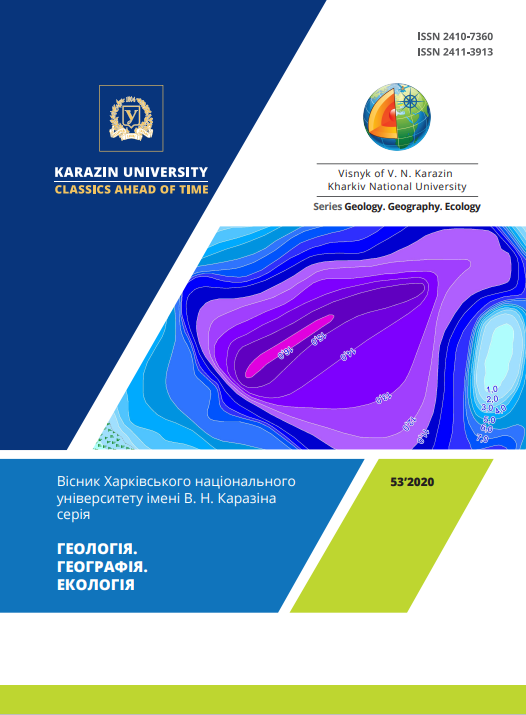Recognition of indicative landscape objects within protected areas
Abstract
Formulation of the problem. In this article the author describes monitoring of landscape objects within protected area. We created 'image of landscape' from remote sensing data. The developed methodology allows to obtain remotely information about visual changes, to analyze and predict the further development of landscapes of the facies level. It is difficult to investigate nature conservation areas at the facies level in areas with plant diversity. Field methods are time-consuming and labor-intensive, but changes can occur frequently. We offer a methodology for identifying indicative landscape objects by creating an image and its visualization using high-resolution satellite imagery decoding Sentinel-2 (resolution 10 m) and Planet Scope (resolution 3 m). This method with using satellite imagery of study makes it possible to gain access to the terrain that is accessible in hard-to-reach places, namely in swampy areas, in dense forest impassable territories and others.
The purpose of the article. The main goal is creating methodic for recognition indicative objects of landscape within protected territories through the appearance of visual changes by the cameral method.
Materials and methods. We have improved the method of processing satellite images to identify indicative objects of changes in landscapes at the facies level. We used the method of controlled classification to obtain "a picture" of the landscape in office conditions, carried out an analysis of comparison on the ground and identified objects of interest. Based on experiments we chosen supervised classification and methods for different resolution of remote sensing data.
Results and scientific novelty. We have changed the traditional landscape study process and approach in our work. We created a landscape rendering model and then carried out work directly on the ground, comparing the characteristics. this allows you to explore the territory at a distance, in hard-to-reach places and in protected areas, which allows a person to analyze information at a distance, predict and take further measures to preserve landscapes and individual objects.
Practical significance. Identification of indicative objects within protected areas allows monitoring changes in landscapes, analyzing and taking measures to preserve them. Systematization of the entire analysis during processing allows you to identify changes in time even in hard-to-reach regions and quickly receive information remotely. The analyzed data allow designing a successful combination of the normal functioning of nature and human activity.
Downloads
References
Alfan H. (2017). Spatial pattern of illegal activities and the impact on wildlife populations in protected areas in the Serengeti ecosystem. York, PhD thesis, University of York. http://etheses.whiterose.ac.uk/id/eprint/20276
Bastian O., Roder M., James F. (2007). A framework for monitoring landscape functions: The Saxon Academy Landscape Monitoring Approach (SALMA), exemplified by soil investigations in the Kleine Spree floodplain (Sax-ony, Germany). Dresden, Landscape and Urban planning, 79, 2, 190-199. https://doi.org/10.1016/j.landurbplan.2006.02.005
Bodnya O. V., Ovcharenko A. Yu. (2018). Indicative landscape monitoring of national natural parks (in the appli-cation of the territory of NPP "Slobozhanskiy"). Kharkiv, V. N. Karazin Kharkiv National University, 49, 192-207. https://doi.org/10.26565/2410-7360-2018-49-15
Biatov A. P., Brusenczova N.O., Saidaxmedova N.B. et al. (2013). Appendix to the Annals of Nature of the Slo-bozhansky National Nature Park for 2012. Krasnokutsk, 136. https://zakon.rada.gov.ua/rada/show/v465_737-02/card6#Public
Bogdanov A. P., Aleshko R. A. (2016). Development of a method for monitoring the state of forests based on the use of multispectral space survey data. Arhangelsk, FBU «Severnyj nauchno-issledovatelskij institute lesnogo hozja-jstva, 98-110. https://doi.org/10.21513/0207-2564-2017-1-98-110
Cheng Y. (2019). Retrieving vegetation phenology with planetscope images for a semi-arid rangeland in Kenya. Enschede, 74. http://purl.utwente.nl/essays/83720
Goryanova V.O., Kvartenko R.O. (2012). Special features of the physical and geographical area in the national natural park "Slobozhansky". Uman, Ecology – the way of harmonizing the common nature and suspension. (11-12 october 2012.), 96-98.
Grodzynskyj M.D. (2017). Geography: the old name of the new science and the revival of the forgotten. K, Ukraini-an Geographical Journal, 2, 65-68. https://doi.org/10.15407/ugz2017.02.059
Hakan A. (2017). Analysis of landscape changes as an indicator for environmental monitoring. Environmental Monitoring & Assessment. 189, 1-10.
Hakkenberg C., Song C., Peet R. (2016). Remotely-sensed predictive models of forest composition: community-unit classification versus continuous gradient modeling. 2016AGUFM.B52A..07H
Houet T., Verburg P., Loveland T. (2010). Monitoring and modelling landscape dynamics. Landscape Ecology, 25, 163-167.
Lambin E. (2001). Remote Sensing and Geographic Information Systems Analysis. Louvain-la-Neuve, International Encyclopedia of the Social & Behavioral Sciences, 13150-13155.
Landscape monitoring using remote sensing NAU students in the Department of Geography, Planning, & Recrea-tion study the desert. https://nau.edu/gpr/landscape-monitoring-using-remote-sensing.
Ovcharenko A. Yu. (2019). Mobility of GIS-technologies in the aspect of the development of large-scale landscape mapping and practical practices of geography students. Kharkiv, «Problemy bezperervnoyi heohrafichnoyi osvity i kartohrafiyi» (na sayti Natsional'noyi biblioteky Ukrayiny imeni V. I. Vernads'koho), 30, 70-80. https://doi.org/10.26565/2075-1893-2019-30-08
Ovcharenko A. Yu. (2019). Review of the study of indicative projects of landscape monitoring using a landscape monopolist using remote sensing technologies. Kharkiv, Geographical research: the history of today, prospects: materials of the international science conference of students and the commemoration of the memory of Professor G.P. Dubinsky (11 April 2019), 12, 39-44.
Perepechena Ju. I., Glushenkov O. I., Korsikov O. I. (2017). Determination of forest cover and quantitative charac-teristics of forests using Sentinel-2 space images (on the example of na primere of the Shebekinsky municipal dis-trict of the Belgorod region). Remote methods in forest, 4, 85-93. https://cyberleninka.ru/
Somers B., Tits L, Roberts D., Werherley E. (2016). Endmember Library Approaches to Resolve Spectral Mixing Problems in Remotely Sensed Data: Potential, Challenges, and Applications. Leuven, Data Handling in Science and Technology, 30, 551-577.
Tretyakov O.S., Bodnia O.V., M.O. Balynska et al. (2015). Features of interpretation of plant association of na-tional natural park «Slobozhanskiy» using Landsat 8 satellite data. Kharkiv, Problemy bezperervnoyi geografich-noyi osvity i kartografiyi: Zbirnyk naukovyx pracz, 21, 73-79.
Villoslada M., Bunce R., Sepp K. et al (2017). A framework for habitat monitoring and climate change modelling: construction and validation of the Environmental Stratification of Estonia. Regional Environmental Change, 2, 335-349. https://doi.org/10.1007/s10113-016-1002-7
Watson D., Doeer V., Banks S. et al (2017). Monitoring ecological consequences of efforts to restore landscape-scale connectivity. Biological Conservation. 206, 201-209. https://doi.org/10.1016/j.biocon.2016.12.032





